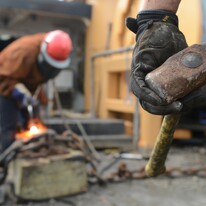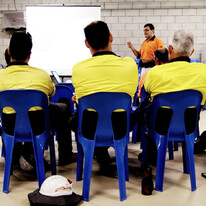Workplace Noise and Training
Regular education can support understanding on the importance of looking after your workers' hearing.
Information you need to provide to your workers
- The impact on their health from harmful noise
- How their hearing could be affected by loud noise
- How and when to use noise control measures
- Where and when to wear hearing protection
- How to choose, fit, wear, maintain and store ear protection equipment
- How to identify and report harmful noise levels
- How to report faulty or damaged hearing protection and noise control equipment
- Dangerous tasks and the level of harmful noise they could be exposed to
- Responsibilities of workers, managers, supervisors and health and safety representatives.
Who needs training?
Training should be provided to:
- Workers who may be exposed to hazardous noise or ototoxic substances (chemicals that could damage your hearing)
- Workers who supervise others working in noisy areas
- Health & Safety Representatives (if you have them)
- The people responsible for buying equipment or machinery which may create excess noise, and for the design, organisation and layout of the workplace.
How much do your workers already know?
Training should be tailored and fit for purpose based on what your workers already know and understand about noise, noise reduction, noise induced hearing loss, risks etc. Consider:
- Your workers have previous experience working in environments where they were exposed to hazardous noise
- Your workers have received any training in the proper use and maintenance of hearing protection, or whether they are new/inexperienced
- Your workers' age, their first language, current disabilities and any cultural differences
- How you will support your workers to demonstrate using and wearing hearing protection correctly
- How you could provide daily reminders of safe work practices (eg posters, toolbox meetings, signs).
Why is training important?
Regular and ongoing education for workers can help to support their understanding on the importance of looking after their hearing. If workers understand how noise can be harmful, and how to manage the risks of noise, they are more likely to protect their hearing in and out of work. You can help your workers to protect their hearing at work by:
- Providing ongoing health and safety training
- Checking how much your workers already know about looking after their hearing
- Providing hearing protection
- Making sure noise is always on the safe site or hazard board
- Having a health and safety agenda item in your weekly team meetings or stand ups. This will give workers the chance to bring up any issues regarding harmful noise levels, or concerns about their own hearing
- Providing information on how to look after their hearing.
Remember, training is most effective when it addresses workers' attitudes and behaviours.
How you can set up good hearing practices in your work
The best way to prevent noise induced hearing loss is to create a work environment promoting good hearing. Engage and involve your workers to describe and set up safe noise practices at work. This means you and your workers will:
- Know how to identify potential loud noises and how to report them
- Understand that hearing loss is permanent
- Describe and share any issues, and receive feedback on managing and addressing noise related hazards
- Plan together to control noise on site before a project starts. Consider how you will reduce noise at your work over the long term (eg by replacing noisy equipment with quieter equipment).
Get in touch today
We can come to your workplace at a time when it suits you (out of hours if need be to catch shift-workers) and take care of all your custom-made ear protection plug needs, all you need to do is make your employees available.
Don’t risk your employees hearing or pay more than you need to in ACC premiums. Call us on 06 929 7608, or email us at contact@earsuctionhb.co.nz and ask us for a quote.
Ear Protection Plugs Hawke's Bay is a division of Ear Suction Hawke's Bay Limited.



